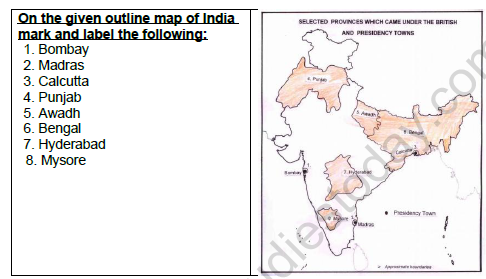HOW, WHEN & WHERE AND FROM TRADE TO TERRITORY
I FILL IN THE BLANKS:
1. 1. James Mill, a Scottish economist and political philosopher, divided Indian history into 3
2. periods – ________________________________________.
3. 2. Many historians refer to the Modern Period in India as ________________, because
4. under British rule, Indians did not have equality, freedom or liberty.
5. 3. By the early 19th century, detailed ______________________were being carried out to
6. map the entire country.
7. 4. _____________________operations, held every ten years, prepared detailed records
8. of the number of people in all the provinces of India, noting information on castes,
9. religions and occupation.
5. ________________________controlled the profitable trade of Malabar Coast from where the Company purchased pepper and cardamom.
6. Tipu Sultan was killed defending his capital in the Battle of _______________________
7. With their defeat in the Third Battle of __________________ , the Marathas’ dream of ruling from Delhi was shattered.
8. The Company took over__________________, arguing that they were ‘obliged by duty’ to take it over, to free the people from the misgovernment of the Nawab.
9. After the death of Maharaja Ranjit Singh and two prolonged wars with the Sikhs _________________ was annexed by the Company.
10. In building a force of professional ___________________the British often ignored caste and community feelings which created problems.
II NAME THE FOLLOWING:
1. 1. India’s first Governor- General. _________________________________
2. 2. India’s last Viceroy. ___________________________________________
3. 3. The Portuguese explorer who discovered the sea route round the Cape of Good Hope.
4. ________________________________________
5. 4. A business enterprise that makes profit primarily through trade, buying goods cheap and
6. selling them at higher prices. _______________________
7. 5. The first English factory was set up on the banks of this river. _________
8. 6. The village which later grew into the city of Calcutta. _________________
9. 7. This Battle was the Company’s first major victory in India. ________________________
8. Political and commercial agents appointed in Indian states by the Company to serve and further their interests. ___________________________
9. The ruler known as the ‘Tiger of Mysore’. ___________________________
10. The lady from Kitoor in Karnataka, who led an anti – British resistance movement. _______________________________________
III

IV ANSWER THE FOLLOWING QUESTIONS:
1. What is meant by ‘colonisation’? What was its effect on India?
2. State the significance of the Charter acquired by the East India Company from Queen Elizabeth I
3. What led to fierce battles between the trading companies?
4. How did the Bengal Nawabs assert their power and autonomy after Aurangzeb’s death?
5. What was the result of the Company getting the Diwani rights of Bengal in 1765?
6. What is the problem with the periodisation of Indian History that James Mill offers?
7. What was the main reason for Sirajuddaulah’s defeat in the Battle of Plassey?
8. Explain the principle of Paramountcy
9. Why did the people of Awadh join the great revolt of 1857?
10.Name the Southern Indian state against which the Company resorted to direct military confrontation. Explain why? Which action of its ruler infuriated the British
11.Explain Subsidiary Alliance
12.Discuss the changes in the composition of the Company’s army in the 18th century
13.Describe the Doctrine of Lapse
14.Throw light on the new system of administration and justice set up the Company
15.‘East India Company transformed from a trading company to a territorial colonial power using a variety of methods.’ Justify with examples
Please click on below link to download CBSE Class 8 Social Science How When Where And From Trade To Territory Worksheet

